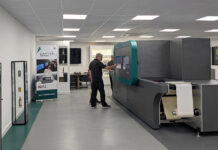
Technological advancements, climate change, and geopolitical tensions have transformed the global manufacturing landscape in recent decades. Here, Carl Haycock, UK operations director, Domino Printing Sciences, considers what the next phase of change will have in store, and identifies five key trends to monitor for the year ahead.
Digital tools for optimisation
Digital tools, including cloud computing and automation, are increasingly used to enable real-time insights and optimisation across production facilities, helping manufacturers improve efficiency, reduce waste, and increase resilience.
Contrary to the perception of many manufacturers, digitisation does not have to be embraced in an ‘eat the elephant whole’ style approach. Indeed, by targeting specific areas of the production process in a bite-sized manner with readily accessible digital tools, common and costly production issues can be easily addressed, helping to improve overall production efficiency.
For example, the simple addition of automated coding solutions and vision inspection systems can enable businesses to streamline product changeovers, limit manual data entry, optimise quality control of products and coding, and improve reporting – all of which can facilitate the acquisition of more information about production processes and a better understanding of production lines, which in turn can pave the way for more creative solutions in the future.
Automation for manufacturing resilience
We’ve seen our fair share of volatility over the last few years, with manufacturers struggling to remain productive while faced with shrinking margins and consumers feeling the pinch of higher prices and longer lead times. In this climate, it’s become increasingly apparent that automation tools are proving increasingly valuable in helping manufacturers to add operational resilience to production processes.
From managing labour and skills shortages and redeploying existing workers into value-added improvement activities to reducing running costs and eliminating errors, automation has been instrumental in helping businesses protect themselves against the many and sundry challenges facing the manufacturing industry over the past few years.
Evidence suggests that continued investment and optimisation could place these same businesses in good stead for future economic uncertainty. Indeed research from Bain & Company has revealed that companies make more dramatic gains and losses during periods of economic uncertainty than during stable periods, highlighting investment in automation as a critical priority for businesses when adjusting strategies to prepare for a recession.
Scalability and sustainability through collaboration
One of the significant global challenges advanced manufacturing seeks to address is sustainability, particularly how to ensure that growth and progress are both economically and environmentally sustainable.
The path to sustainable development involves addressing many economic, social, and environmental challenges, necessitating coordinated efforts and collaboration with various stakeholders with potentially competing short-term objectives, to ensure that growth and innovation in one field doesn’t have unforeseen negative impacts elsewhere.
Take for example, the development of sustainable packaging solutions which requires collaboration from the whole value chain – from manufacturers, packaging providers, and coding and marking suppliers, to retailers, end users, and waste and recycling companies. These new systems require a step change in packaging design, management, and technology. In all instances, collaboration between brands, packaging providers, retailers, and technology partners becomes critical.
In the coming years, as companies increasingly look to develop new systems and solutions for sustainability, collaboration, and, in particular, open innovation – that is, being open to sharing and receiving information and working with individuals, businesses, and institutions to drive progress on common objectives – will help to ensure that businesses can make significant change in a way that benefits everyone.
Human-automation interaction
In his book, The Fourth Industrial Revolution, Professor Karl Schwab, founder and executive chairman of the World Economic Forum, called for leaders and citizens to work together to ‘shape a future that works for all by putting people first, empowering them and constantly reminding ourselves that all of these new technologies are first and foremost tools made by people for people’.
Today’s conversations surrounding AI inevitably bring up concerns around the replacement of human workers – the likes of which have been seen during every period of human growth dating back to the first industrial revolution – however, for the short term at least, the opposite is likely to be true, and businesses should prepare themselves for increased interaction between manual workers, and digital tools.
Indeed, Forbes suggests AI will enable workers to focus on more meaningful and high-value activities, including design and management tasks, in the coming years. At the same time both MIT and Statista suggest that human-robot collaborations will be the future of manufacturing – with a 2016 study from MIT finding that teams made of humans and robots could be up to 85% more productive than teams made of either humans or robots alone.
Preparing a workforce for AI projects will be an ongoing process. As technologies evolve, businesses must invest in learning and development to ensure employees remain equipped with the skills and knowledge needed to progress.
Predictive mindset approach
Just as the industry is on a journey towards digitisation, automation, and smart solutions, so too are today’s service and maintenance technicians and engineers. These people have always played a key role within manufacturing operations; when a machine fault or an issue arises which causes production to stop a service or maintenance engineer is often the go-to person, trusted to identify and fix the problem to get the system back online.
However, this traditional ‘break and fix’ model of service and support falls short of modern-day manufacturing requirements. Manufacturing uptime is vitally important to ensure customer service levels are met efficiently with minimal investment in excess inventory and other forms of waste. Worst case, waiting for a specialist service technician to travel across country to attend a site can be highly disruptive, costly, and detrimental to the environment. Preparedness can only be achieved with a fundamental shift in service and support, to focus on predictive uptime monitoring and proactive quality improvement.
The service engineer of the future will have a varied skill set adding remote consultative capabilities and knowledge and understanding of data analytics to their technical knowledge and face-to-face interaction skills. This new breed of data-driven service engineer will be able to identify and fix potential problems with machinery before they cause issues on the line and, potentially, before a manufacturer even realises there is a problem.
Conclusion
The last decades have seen the rapid evolution of manufacturing production lines further sped up by the circumstances imposed by the Covid-19 pandemic, geopolitical tensions, and a global focus on sustainability.
In this new advanced manufacturing environment, digital tools – from coding automation and automated vision inspection systems to data visibility and cloud-based remote monitoring systems – underpin production line optimisation and business resilience, supporting the drive towards sustainable solutions and enabling a new breed of workforce, with skills supported and enhanced by automation.
These are the trends of today that will shape tomorrow’s manufacturing industry.












